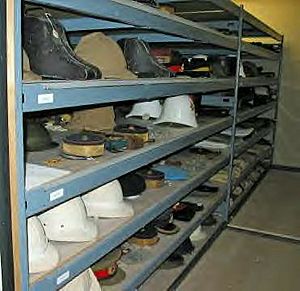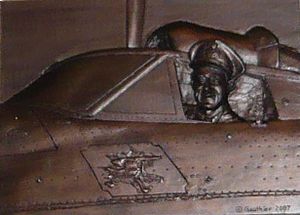Royal Military College of Canada Museum facts for kids
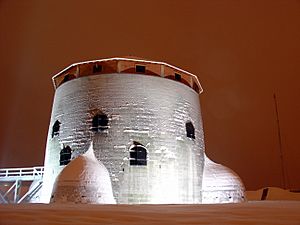 |
|
| Established | 1962 |
|---|---|
| Location | Fort Frederick 4 Passchendale Dr. on the campus of the Royal Military College of Canada Kingston, Ontario Ontario East |
| Type | military history |
The Royal Military College of Canada Museum opened in 1962. It is located inside a special round building called a Martello tower. This tower is known as Fort Frederick. It sits on the campus of the Royal Military College of Canada (RMC) in Kingston, Ontario. The college itself runs the museum.
Before 2016, the museum was open regularly during the summer. Entry was free, but people could give donations. You could also get guided tours in English and French. The museum also helped people research family history related to the college.
In 2016, work started to fix up Fort Frederick. The museum had to move out of the tower. This meant it no longer had a public space to show its exhibits. You can still visit the museum and its historic site online through the Virtual Museum.
The Martello tower that houses the museum was built around 1790. It was mostly made of earth with a stone wall on the north side. It is now a recognized historic place in Canada. Fort Frederick is one of four Martello Towers built between 1846 and 1848. They were made by the Royal Engineers to help protect Kingston. This Martello tower was named after Frederick, Prince of Wales.
Contents
What the Museum Does
The museum's main job is to collect, protect, study, and show items. These items tell the story of the Royal Military College of Canada (RMCC). They also highlight the achievements of its graduates. The museum also covers the naval history of the area. This includes the Kingston Royal Naval Dockyard that used to be at Point Frederick.
Museum Collections
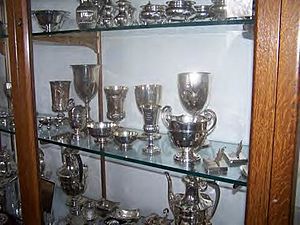
The museum has many interesting items. These include military memorabilia and about 7,000 other pieces. You can see weapons from the 16th to 20th centuries. There are also uniforms, flags, military art, and trophies.
For example, the museum has the Douglas Arms Collection. Walter Douglas (who attended RMC in 1890) gave this collection to the college. It has over 400 guns that once belonged to Mexican President, General Porfirio Diaz. Another important collection is the Leinster Plate. This is a set of silverware from the Prince of Wales's Leinster Regiment. The Nanton Arms collection was given by J. Nanton (RMC 1882). It includes Indian daggers and other weapons. These were given to Nanton by the Maharajah of Cooch Behar when he served in India.
A model of the 112-gun HMS St Lawrence (1814) was given to the museum in 2008. The bottom floor of the Martello tower shows exhibits about the War of 1812. It also covers the fort’s dockyard. The main floor tells the story of the college. It also has personal items from the "Old Eighteen." These were the first students who joined in 1876. Cannons are displayed on a gun platform at the top of the tower. The museum's archives also hold maps, drawings, old papers, and photos.
The museum also looks after a collection of Canadian landscape and military art. These include paintings, sculptures, and stained glass windows. You can see these artworks around the college, especially in Currie Hall and Yeo Hall. In 2011, the college announced a new art display area in the New Learning Center.
Art Collection Details
Since 2010, the Royal Military College of Canada Museum has been in charge of the college’s art collection. This collection has over 1,000 two-dimensional artworks. These include paintings, prints, and drawings. It also has three-dimensional works like sculptures and stained glass. About 20% of the art is on display at the college. The rest is stored in Fort Haldimand.
The art collection includes works by famous artists. Some of these are Admiral Henry Wolsey Bayfield, Charles Comfort, Lawren Philip Harris, and C.W. Jefferys. Many artworks were given to the college by former students or graduating classes. They were often given as gifts, memorials, or through special orders. For example, the Class of 1974 gave the Gauthier Collection. This collection has 60 military sculptures by Col (Ret’d) André Gauthier.
Working with Other Groups
The museum is part of several important groups. It is a member of the Canadian Museums Association. It also belongs to the Organization of Military Museums of Canada Inc. The museum is approved by the Canadian Forces Museum System. It works closely with the Canadian Heritage Information Network and the Virtual Museum of Canada. A group of friends of the museum also helps with projects.
Parks Canada often works with the Royal Military College of Canada Museum. They sometimes offer joint programs or provide support.
| Year | What Happened |
|---|---|
| 1918 | The RMC Commandant, Brigadier Charles N. Perreau, wanted to start a museum at RMC. The college began collecting items bit by bit. |
| 1920 | Major-General Sir Archibald Macdonell, another RMC commandant, gathered war trophies for the college. He asked for more trophies to be sent to RMC. |
| September 1922 | An army board met at RMC to see if a museum could be created in Fort Frederick. They decided it was a good idea. |
| January 1926 | National Defence Headquarters wanted the RMC museum to be the main place for military items. |
| February 1926 | An inventory showed that RMC had many items. These included hundreds of weapons and clothing from 1914–1918, many captured from the Germans. |
| 1938 | Walter Douglas (RMC 1890) gave RMC a collection of 430 weapons. These had belonged to former Mexican President Porfirio Díaz. |
| July 1946 | RMC decided to close its museum. Many items were given to other military museums. |
| 1957 | The army created rules for how military museums could be started and how they could get equipment or war trophies. |
| 1960 | The idea of reopening the RMC museum came up again. The old cases of items were finally opened. |
| 25 June 1962 | The new RMC Museum officially opened. It is in the Martello tower at Fort Frederick, where it is today. |
| 2007 | An old swimming pool in Fort Haldimand was filled in. This area was turned into a two-story storage space for the museum. |
| 2010 | The Royal Military College of Canada Museum became responsible for the college’s art collection. |
War Trophies and Memorials
The museum's curator looks after the war trophies and memorials around the college. These are special items that remember military events or people.
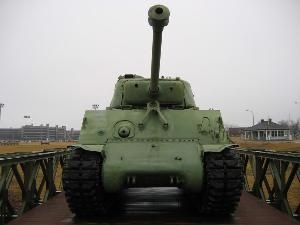
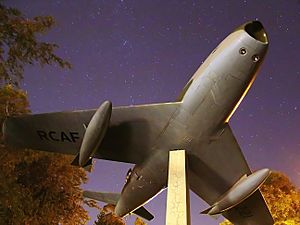
| Artillery or Cannon | Description | Location |
|---|---|---|
| Blomefield 32-pounder Gun | Made in 1806, with King George III's symbol. | Fort Frederick Tower 3 North. |
| Blomefield 32-pounder Gun | Made in 1807, with King George III's symbol. | Fort Frederick Tower 3 East. |
| Blomefield 32-pounder Gun | Made in 1811, with King George III's symbol. | Fort Frederick Tower 3 West. |
| Blomefield 32-pounder Gun | Made by Walker Co, with King George III's symbol. | Parade Square North East. |
| Millar 32-pounder Gun | Made by Walker Co in 1842, with King George III's symbol. | Fort Frederick 2. |
| Blomefield 32-pounder Gun | Made by Carron in 1807, with King George III's symbol. | Fort Frederick 3. |
| Blomefield 32-pounder Gun | Made by Walker Co, with King George III's symbol. | Fort Frederick 5. |
| Blomefield 32-pounder Gun | Made by Walker Co in 1842. | Fort Frederick 6. |
| Blomefield Palliser 32-pounder Gun | Updated in 1870, with Queen Victoria's symbol. | Paint Yard. |
| Blomefield Palliser 32-pounder Gun | With Queen Victoria's symbol. | Paint Yard. |
| Blomefield 32-pounder Gun | Made by Walker Co, with King George III's symbol. | Crerar Gateway West. |
| Blomefield 32-pounder Gun | Made by Walker Co, with King George III's symbol. | Crerar Gateway East. |
| Blomefield 32-pounder Gun | Made by Carron in 1807, with King George III's symbol. | Fort Haldiman. |
| Blomefield 32-pounder Gun | With King George III's symbol. | MacDonald West. |
| Blomefield 32-pounder Gun | Made by Walker Co, with King George III's symbol. | MacDonald East. |
| 24-pounder Gun | Made in 1847, with Queen Victoria's symbol. | Fort Frederick North East 1, on a long wooden carriage. |
| 24-pounder Gun | Made in 1847, with Queen Victoria's symbol. | Fort Frederick 7, on a long wooden carriage. |
| 24-pounder Brass Gun | Made in 1843, with Queen Victoria's symbol. | Senior Staff Mess North. |
| 9-pounder Brass Gun | Made in 1859, with Queen Victoria's symbol. | Senior Staff Mess South. |
| 9-pounder Brass Gun | Made in 1813, with King George III's symbol. | Flagpole East. |
| 9-pounder Brass Gun | Made in 1812, with King George III's symbol. | Flagpole West. |
| 32-pounder Gun | Made by Carron. | Fort Frederick Tower 2 North West. |
| 32-pounder Gun | Made by Carron in 1808. | Fort Frederick Tower 2 North. |
| 32-pounder Gun | Made by Carron in 1804. | Fort Frederick Tower 2 North East. |
| 32-pounder Gun | Made by Carron. | Fort Frederick Tower, Main South. |
| 32-pounder Gun | Made by Carron. | Fort Frederick Tower, Main North. |
| 32-pounder Gun | Made by Carron. | Fort Frederick Tower, Main North East. |
| 10-inch Mortar | Made by Walker Co in 1856. | Stone Frigate North. |
| 10-inch Mortar | Shot in the muzzle. | Stone Frigate South. |
| Armstrong 7-inch Gun | Made in 1862, with Queen Victoria's symbol. | Fort Frederick 4, on a long wooden carriage. |
| Blomefield 12-pounder Gun | A 2-foot long gun piece. | Fort Frederick Tower B. |
| Blomefield 12-pounder Gun | A 2-foot 5-inch long piece, stuck in the road. | Main Gate North. |
| Blomefield Gun | A 2-foot 5-inch long piece, stuck in the road. | Main Gate South. |
| German Second World War 8.8-cm FlaK 37 Anti-Aircraft Gun | A German anti-aircraft gun. | Crerar Crescent. |
| German Second World War 8.8-cm Panzerabwehrkanone 43 Anti-tank Gun | A German anti-tank gun part. | Crerar Crescent. |
| Ordnance QF 25-pounder Gun | A 25-pounder gun. | Massey Library, by the Cadet statue. |
| M109 155-mm Self-propelled Howitzer | A large self-propelled cannon. | Training Aid, RMC. |
| Other Memorials | Description |
|---|---|
| Carriage Lamps on Crerar Gates | Donated by the Class of 1985. |
| Aircraft Avro CF-100 Canuck Mark 5 | Presented by the Class of 1972. It was fixed up and rededicated in 1996. |
| Aircraft Sabre | Presented by the Class of 1968, fixed up in 1996. |
| Sherman Tank Model A2E8 | Presented by the Class of 1971. |
| Centurion Tank Mark 5 | From the Class of 1979. |
| Leopard tank | |
| Gazebo behind Fort Champlain | From the Class of 1966. |
| Information Kiosk - history of RMC and Memorial Arch | Built as part of the Memorial Arch repair project. |
| Sidewalk- "Route 66" | Runs from Potters Lodge to Massey Building, from the Class of 1966. |
| 3 stained glass windows in Mackenzie Building | Represent the Navy, Army, and Air Force. Designed by Robert Jekyll, from the Class of 1956. |
See also


